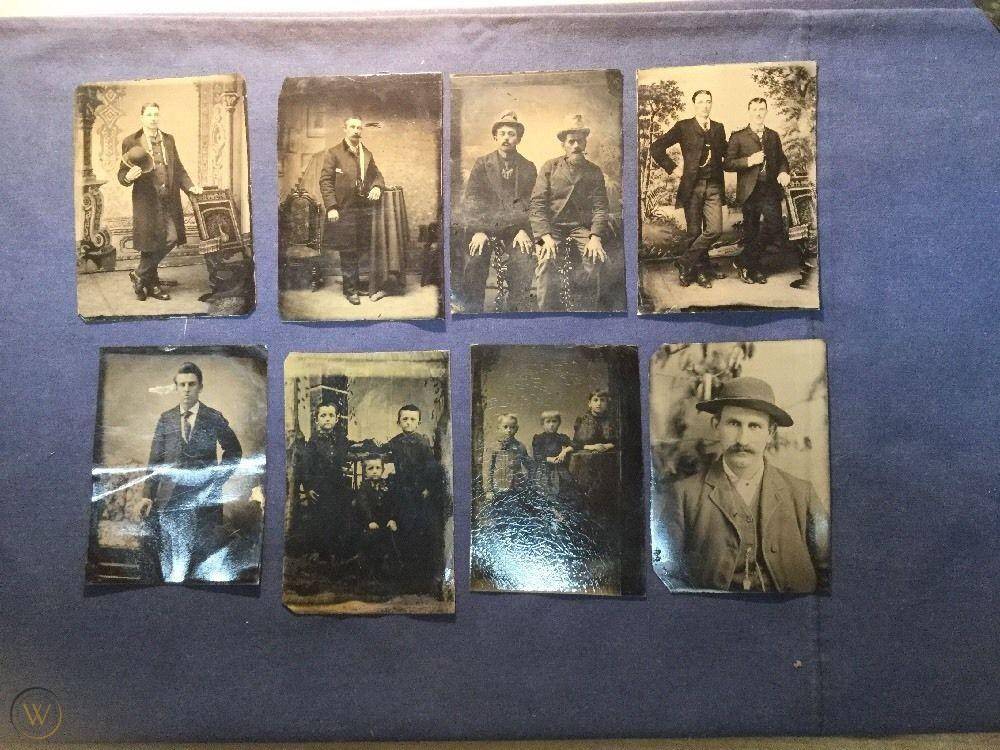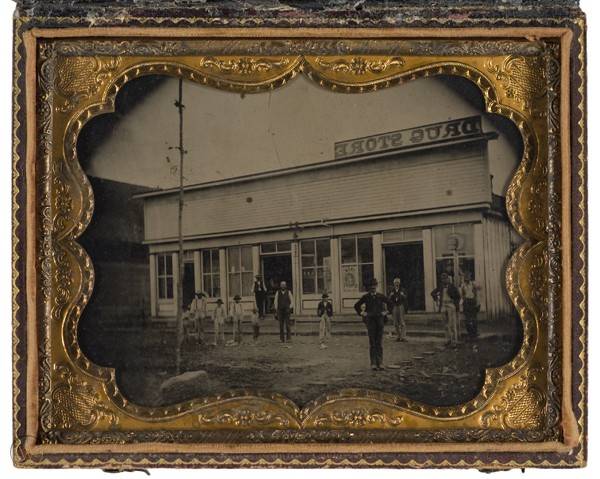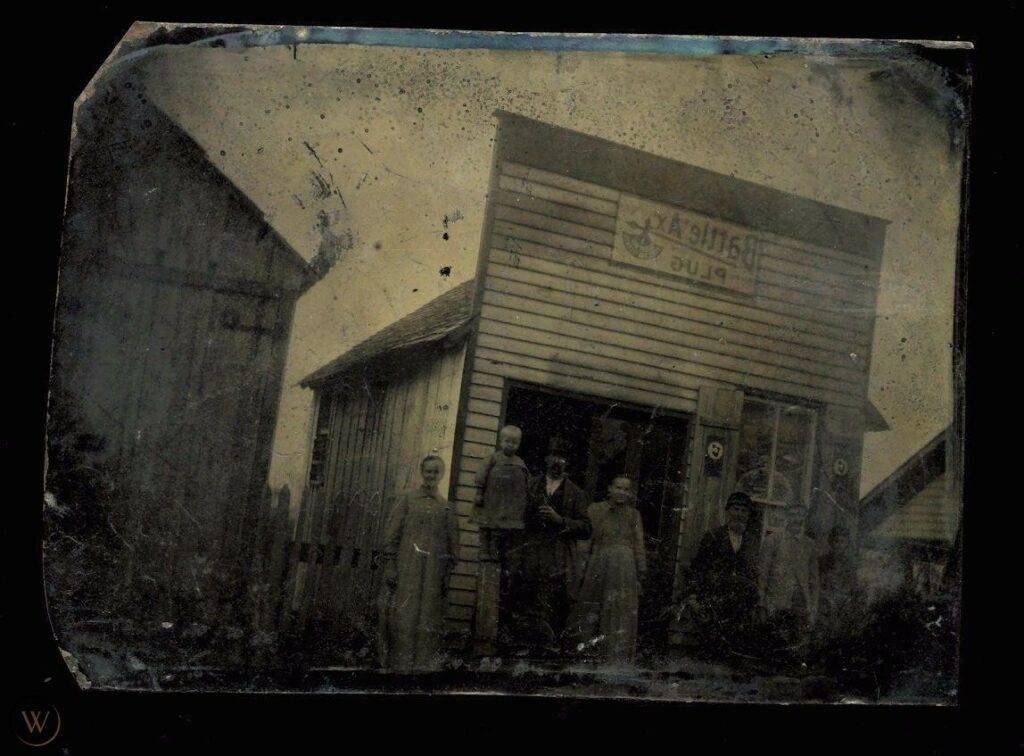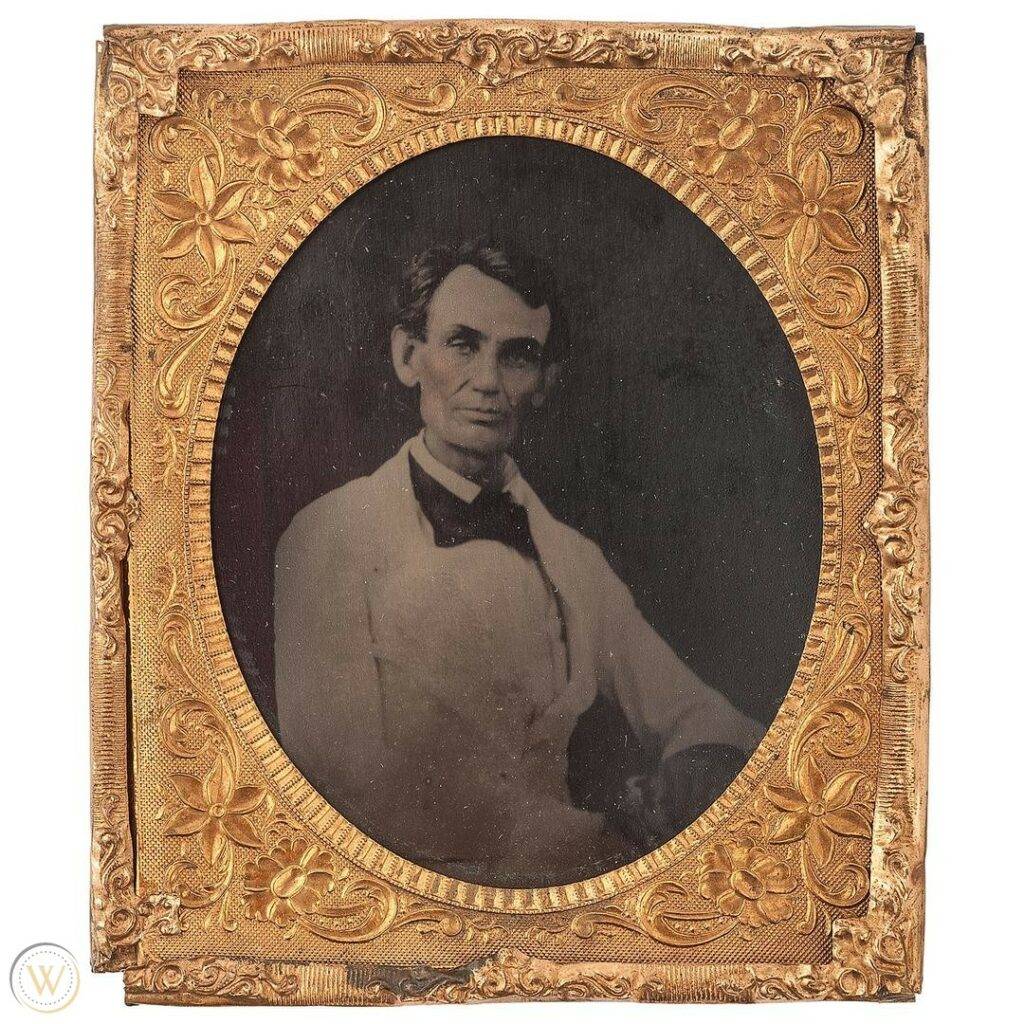
A Brief History
Colloquially known as “tintypes” due to the cheap metallic feeling of their materials, ferrotypes first appeared in the United States in the mid-19th century. The first American-developed photography method, ferrotypes were made by brushing a light-sensitive emulsion on a thin metal sheet, a derivation of the collodion wet plate process. Iron plates, not tin, were coated in a viscous mixture of nitrate and alcohol, often immediately prior to exposure, as the dry plate method would not gain popularity until the end of the century. The plate was exposed to light by removing the cap and protective plate within the camera, producing an underexposed image that was then processed and coated with dark enamel. This process actually produces what would be considered a negative image (in which the light and dark areas are inverted), but we perceive it as a positive image because of the ferrotype’s dark lacquering or enameling, creating an illusion that more closely resembles a traditional positive print.
Ferrotypes were very popular for nearly a century because they were a quick, cheap method of capturing memories on vacation or at short-lived events like circuses or arcades. The materials were especially cheap when compared to the glass needed for ambrotypes (another popular technique of the time), and thus, the ferrotype became a more cost-effective alternative. According to the Library of Congress, tintypes were often sold for around 25 cents (or about $3 in 2021) in the 1860s and up to $2.50 (about $75 in 2021) in higher-demand areas, like the South during the Civil War.

Identifying Tintypes
Because tintypes enjoyed lasting popularity and were widely produced, they’re relatively easy for collectors to find today. The dark, moody images created by tintypes have an enduring appeal, so it comes as no surprise they are widely collected. Identifying tintypes can take some practice, but there are a few key features to bear in mind. Because the images were created by using an iron plate, you can often quickly identify tintypes by using a magnet. A magnet will be attracted to a tintype but will not respond to the glass used for ambrotypes.
However, this is not a foolproof method, as some ambrotypes have been found backed by a sheet of metal. Papier-mâché envelopes were often used as a cheap means of protecting tintype images, but you will also find tintypes stored in frames and cases which can make it more difficult to inspect them and distinguish them from ambrotypes. If you have an image in a protective case or frame, I would not recommend trying to remove the image yourself, as this can cause damage. In these situations, look carefully at the image, as this can help you determine if the enclosed image is an ambrotype or tintype. A tintype is not produced from a negative, so the resulting image will appear reversed. For instance, any text or signs will be backwards in a tintype, so seeking out these details can help you distinguish between tintypes and ambrotypes (which are not reversed). You can see this in the tintype below.

Quality can be another distinction. Tintypes are usually of poorer quality than ambrotypes and have an overall darker appearance. Rust, or blistering (areas where the enamel or lacquer is lifting off the surface), are good indicators that the image is a tintype.
Size can also be helpful when you’re distinguishing tintypes. According to the Library of Congress, tintypes were often produced in the following standard sizes:
Sixteenth Plate, 1.5” x 1.75”
Ninth Plate 2” x 2.5” (the most common size)
Sixth Plate 2.75” x 3.25”
Quarter Plate 3.25” x 4.25”
Half Plate 4.25” x 5.5”
Whole Plate 6.5” x 8.5”
Imperial, or Mammoth, anything larger than whole plate size.
If a print is close to one of these sizes, it could be an indication that an image is a tintype, but take these standard sizes as loose guidelines as tintypes were often hand-cut, or trimmed after the fact, and thus you will get variations in size and edge treatments. Small prints are by far the most common, with some even being produced at such a small scale they could fit into lockets.
Determining Value and Price
Tintypes are quite easy to find in resale markets and can be highly collectible, depending on the content. By far, the most sought-after tintypes are those depicting Civil War portraits, particularly if the subjects are in uniform and holding any sort of weaponry. People often also collect outdoor scenes and landscapes, which are considered novelties since most tintype photography was done within a studio. In fact, some experts can even identify where and when a tintype was created based on the backdrop and props as some studios produced numerous images. Less common imagery, and thus more sought after, include portraits of Native Americans and African Americans, as well as images of circus performers and traveling cowboy shows. There is a niche market for post-mortem (after death) photography, which was very popular within the Victorian era. Portraits of children, animals, and people holding unusual or period-specific props, like weapons or toys, are also highly sought after.

Pricing often reflects the rarity of the image, both in terms of its size and content. Larger tintypes are less common and usually command higher prices, particularly if they depict one of the aforementioned subjects, bringing higher prices than the more common family portrait. To determine price, search for previous sales of similarly sized images with a comparable depiction, in corresponding condition. Auction results, and sites like eBay, can be good resources for determining price. Always be cognizant that fake tintypes are available, as the process is easy to duplicate. Seek the opinion of a professional appraiser to verify the age and value of a tintype if you’re ever in doubt.
Sources and Further Reading:
Library of Congress’s Introduction on Ambrotypes and Tintypes
Science & Media Museum’s Guide to Spotting a Ferrotype
This article was originally published by WorthPoint on WorthPoint.com

